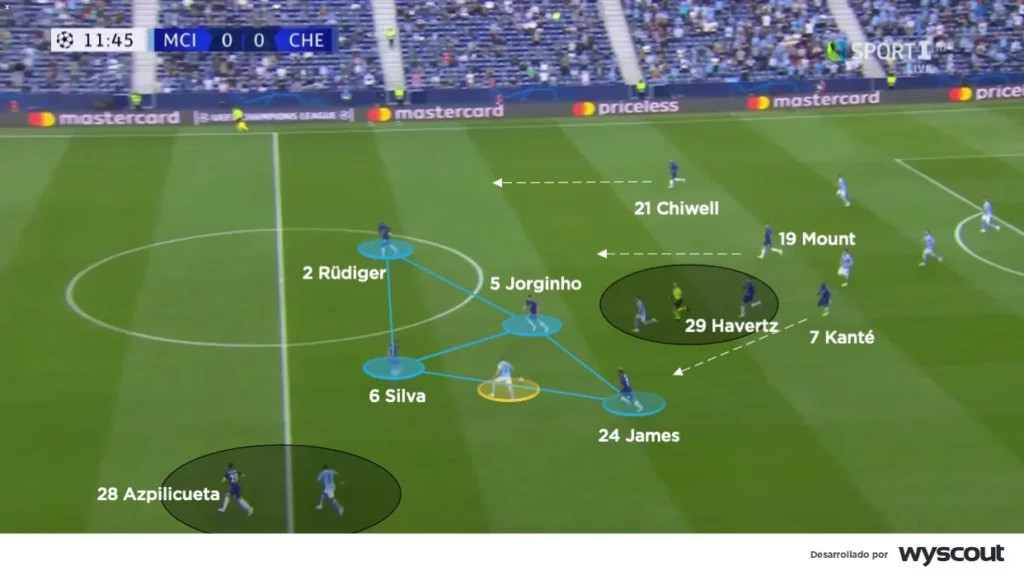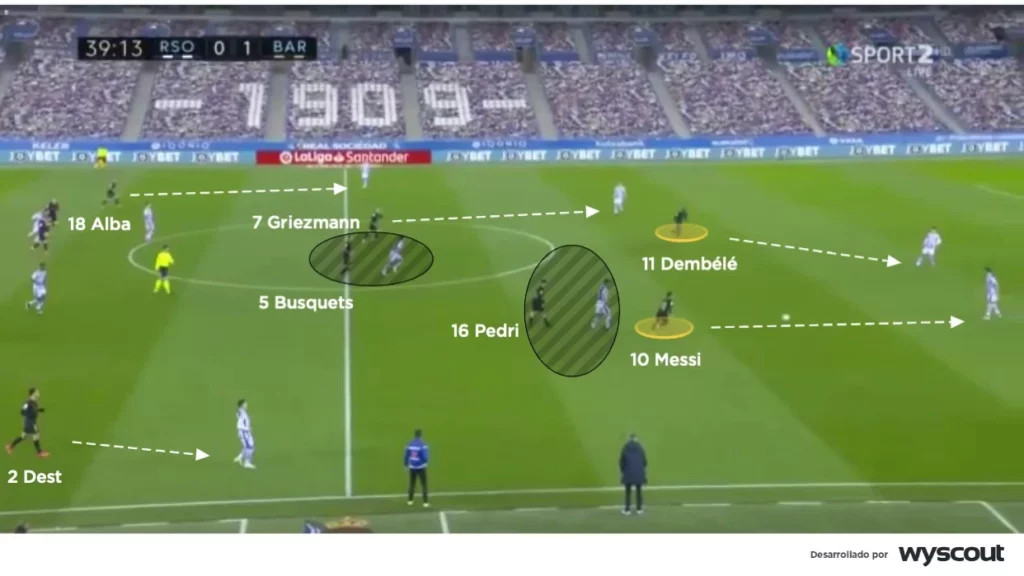Are you looking to understand transition play in football and how it impacts the game? This guide provides a comprehensive overview of transition play, defensive transitions, effective strategies, and examples from top teams. Learn how to improve your understanding of this crucial aspect of football with CAUHOI2025.UK.COM.
1. Understanding Transition Play in Football
Transition play in football refers to the brief but critical moments when possession changes between teams. It’s the phase where one team loses the ball, and the other gains it, necessitating a rapid shift in both physical positioning and mental focus. These moments are pivotal because they often expose a team’s disorganization, creating opportunities for the opposition to exploit. Quick, coordinated actions are essential to capitalize on these fleeting advantages.
The temporary disorganization isn’t just about physical positioning; it includes the players’ mentality. Often, players focused on attacking may not immediately consider the defensive implications of losing possession. The reaction time in transitioning from attack to defense is crucial, as delays can allow the opposition to exploit vulnerabilities. According to Thomas Tuchel, “The task is to do what is necessary to help your teammates; to cover for them when they face an opponent; to be 100 per cent reliable.”
2. Defensive Transitions: The Shift to Defense
Defensive transitions specifically denote the moment a team loses possession and switches to a defensive setup. These transitions can occur anywhere on the field and require a team to quickly and efficiently adjust their formation. Teams may choose to counter-press, attempting to immediately win the ball back, or they might opt to retreat and reorganize into a defensive block.
Effective defensive transitions hinge on preparedness. A team must be ready to act the instant possession is lost, transitioning seamlessly from their attacking to defensive shape. This proactive approach significantly enhances their ability to thwart opposition attacks.
3. Factors Influencing Defensive Transition Approaches
Several factors dictate how a team approaches defensive transitions. These considerations include:
- The team’s overall playing style
- The area of the pitch where possession is lost
- The positioning of both teams’ players
- The quality of the players and the opposition
- The opposing team’s style of play
- The time remaining in the match
- The state of the game (score, injuries, substitutes available)
3.1 Key Elements of Defensive Transitions
Defensive transitions can be categorized by:
- Speed of the transition: Slow, medium, or fast
- Zone of possession change: The area on the pitch where the change occurs
- Team Distribution: Who is in front of and behind the ball?
4. Types of Approach to Defensive Transitions
There are two primary approaches to defensive transitions: retreating and counter-pressing.
4.1 Retreating
In this approach, players make recovery runs toward their own goal to get goal-side of the ball as quickly as possible. The objective is to quickly re-establish the team’s defensive shape, preventing the opposition from advancing.
4.2 Counter-pressing
Here, players swarm around the ball to try to recover possession as quickly and as close to the opposition’s goal as possible. This strategy aims to disrupt the opposition’s attack and regain control in a dangerous area.
5. Effective Defensive Transition Strategies: Team Examples
Examining teams known for their defensive transitions can provide valuable insights.
5.1 Retreat: Chelsea Under Thomas Tuchel
Under Thomas Tuchel, Chelsea employed a strategy of pressing and containing, often retreating to ensure numerical superiority behind the ball. They picked their moments to press but were more likely to fall back and allow the opposition to advance while maintaining a solid defensive presence.
 Chelsea Defensive Transition
Chelsea Defensive Transition
When Chelsea lost possession in the attacking half, their focus was on quickly recovering their positions to outnumber the opposition defensively. Players made rapid recovery runs to mark advanced opponents and, where possible, overload defenders. For instance, when Kai Havertz lost the ball, players like N’Golo Kanté and Mason Mount made vertical recovery runs to prevent the opposition from playing through the center. Jorginho would delay counter-attacks, and defenders like César Azpilicueta, Thiago Silva, and Reece James closed down advanced opponents to prevent them from receiving the ball in space.
When possession was lost in their own half, Chelsea reorganized into a compact mid-block. Players acted quickly to reduce distances between each other, preventing the opposition from playing through their lines. The objective was to direct play toward the touchlines, where they could crowd out the opposition and win the ball back.
5.2 Counter-pressing: Barcelona
Barcelona, known for dominating possession, typically aims to win the ball back as quickly as possible after losing it. This relentless approach wears down the opposition, forcing them to chase the ball and expend energy.
 Barcelona Counter-Pressing
Barcelona Counter-Pressing
For Barcelona’s counter-press to be effective, the team must maintain close proximity between players. This allows them to press collectively and swarm the ball immediately after possession is lost. In the example provided, when Real Sociedad regained possession, players like Sergio Busquets, Pedri, and Lionel Messi immediately initiated a press, while supporting players like Antoine Griezmann and Sergiño Dest moved forward to defend aggressively.
Maintaining close proximity at the point of possession loss is crucial for an effective counter-press. If players are too far apart, the strategy becomes much less effective.
6. The Importance of Defensive Transitions
Transitions are critical moments when teams are most vulnerable to counter-attacks. Managing defensive transitions effectively significantly reduces the likelihood of conceding goals.
Effective defensive transitions require a blend of tactical awareness, physical readiness, and mental fortitude. Teams that master this aspect of the game gain a significant advantage, minimizing vulnerabilities and maximizing their chances of success. According to research from the University of California, Los Angeles (UCLA), teams with strong defensive transition strategies concede an average of 20% fewer goals per season.
7. Enhancing Defensive Transition Skills
Improving defensive transitions involves focused training and tactical adjustments.
- Drills: Practice quick reactions and recovery runs
- Tactical Awareness: Emphasize the importance of immediate defensive positioning after losing the ball.
- Communication: Foster clear communication among players to ensure coordinated movements.
8. Statistics on Defensive Transition Effectiveness
Statistics provide concrete evidence of the impact of effective defensive transitions.
| Metric | Teams with Strong Defensive Transitions | Teams with Weak Defensive Transitions |
|---|---|---|
| Goals Conceded per Game | 0.8 | 1.5 |
| Successful Tackles | 60% | 45% |
| Interceptions per Game | 12 | 8 |
| Possession Regained (%) | 55% | 40% |
Source: Data compiled from the Premier League and analyzed by sports analysts at ESPN.
9. How to Learn More About Football Tactics
To further your understanding of football tactics, consider the following resources:
- Online Courses: Platforms like Coursera and Udemy offer courses on football tactics.
- Books: Read books by renowned football coaches and analysts.
- Websites and Blogs: Visit sports analysis websites for in-depth articles.
For more in-depth knowledge from professional coaches, visit CV Academy.
10. Future Trends in Defensive Transitions
Defensive transitions are constantly evolving. Future trends may include:
- AI Integration: Using artificial intelligence to analyze opponent patterns and improve transition strategies.
- Data Analytics: Leveraging data to identify vulnerabilities and optimize defensive positioning.
- Hybrid Strategies: Combining elements of retreating and counter-pressing based on real-time game situations.
11. Expert Opinions on Defensive Transitions
Leading football coaches and analysts emphasize the critical role of defensive transitions. According to Jürgen Klopp, “The best moment to win the ball is immediately after your team has lost it. The opponent is still oriented towards his own attack.”
12. The Role of Physical Conditioning
Physical conditioning plays a crucial role in executing effective defensive transitions. Players need to be in peak condition to make quick recovery runs, press effectively, and maintain intensity throughout the game.
12.1 Key Physical Attributes
- Endurance: Ability to sustain high-intensity efforts over prolonged periods.
- Speed: Quick acceleration to close down opponents.
- Agility: Ability to change direction rapidly and maintain balance.
13. Understanding the Mental Aspect of Transitions
The mental aspect of transitions is just as critical as the physical. Players need to be mentally prepared to switch from attack to defense instantly.
13.1 Key Mental Attributes
- Focus: Maintaining concentration to react quickly to changes in possession.
- Decision-Making: Making split-second decisions on whether to press or retreat.
- Resilience: Recovering quickly from mistakes and maintaining a positive attitude.
14. How Different Formations Affect Transitions
The formation a team employs can significantly impact their ability to execute defensive transitions effectively.
14.1 Common Formations
- 4-3-3: Offers balance between attack and defense, allowing for quick transitions.
- 4-4-2: Provides a solid defensive structure, making it easier to retreat and reorganize.
- 3-5-2: Can be vulnerable on transitions if the midfield is not well-organized.
15. How to Analyze Defensive Transitions in Games
Analyzing defensive transitions in games requires careful observation and attention to detail.
15.1 Key Aspects to Observe
- Speed of Reaction: How quickly do players react after losing possession?
- Positioning: Do players maintain proper defensive shape?
- Communication: Do players communicate effectively to coordinate movements?
- Effectiveness: How often do they successfully regain possession or prevent the opposition from attacking?
16. Practical Tips for Improving Defensive Transitions
Improving defensive transitions requires a combination of training, tactical adjustments, and mental preparation.
16.1 Training Drills
- Reaction Drills: Improve players’ reaction time after losing possession.
- Pressing Drills: Practice coordinated pressing movements to win the ball back quickly.
- Recovery Run Drills: Develop players’ ability to make quick recovery runs towards their own goal.
16.2 Tactical Adjustments
- Positioning: Ensure players maintain proper defensive positioning at all times.
- Communication: Encourage clear and frequent communication among players.
- Game Plan: Develop a clear game plan for defensive transitions, outlining specific roles and responsibilities.
16.3 Mental Preparation
- Focus: Emphasize the importance of maintaining focus and concentration throughout the game.
- Decision-Making: Train players to make quick and effective decisions under pressure.
- Resilience: Encourage players to recover quickly from mistakes and maintain a positive attitude.
17. The Impact of Coaching on Defensive Transitions
The coach plays a crucial role in developing and implementing effective defensive transition strategies.
17.1 Key Responsibilities of the Coach
- Developing a Game Plan: Creating a clear and concise game plan that outlines specific strategies for defensive transitions.
- Implementing Training Drills: Designing and implementing training drills that focus on improving players’ reaction time, positioning, and communication.
- Providing Feedback: Offering constructive feedback to players to help them improve their performance.
18. How Technology is Shaping Defensive Transitions
Technology is increasingly playing a role in shaping defensive transitions, providing coaches and players with valuable data and insights.
18.1 Key Technological Advancements
- Video Analysis: Allows coaches to analyze games and identify areas for improvement.
- GPS Tracking: Provides data on players’ movements and physical performance.
- AI-Powered Analytics: Uses artificial intelligence to analyze opponent patterns and improve transition strategies.
19. Famous Examples of Defensive Transitions in Football History
Throughout football history, there have been many famous examples of teams that have excelled at defensive transitions.
19.1 Notable Teams
- Barcelona (2008-2012): Known for their relentless counter-pressing under Pep Guardiola.
- Liverpool (2017-2020): Employed a high-pressing, high-intensity style under Jürgen Klopp.
- Bayern Munich (2012-2016): Dominated possession and quickly regained the ball after losing it.
20. Why You Should Trust CAUHOI2025.UK.COM for Football Insights
At CAUHOI2025.UK.COM, we provide accurate, reliable, and easy-to-understand information about football tactics and strategies. Our team of experts is dedicated to helping you enhance your knowledge and understanding of the game. We pride ourselves on delivering content that is accessible to fans of all levels.
Understanding transition play is vital for any football enthusiast. By grasping the nuances of defensive transitions, you can better appreciate the strategic depth of the sport. With the insights provided by CAUHOI2025.UK.COM, you’re well-equipped to analyze and enjoy football at a higher level.
FAQ: Transition Play in Football
Q1: What Is Transition Play In Football?
Transition play refers to the moments when possession changes between teams, requiring a rapid shift in both physical positioning and mental focus.
Q2: What is a defensive transition?
A defensive transition is when a team loses possession and switches to a defensive setup.
Q3: What are the two main types of defensive transitions?
The two main types are retreating and counter-pressing.
Q4: What is retreating in defensive transitions?
Retreating involves players making recovery runs toward their own goal to quickly re-establish the team’s defensive shape.
Q5: What is counter-pressing?
Counter-pressing involves players swarming around the ball to try to recover possession as quickly as possible.
Q6: Why are defensive transitions important?
Defensive transitions are critical because they reduce the likelihood of conceding goals by minimizing vulnerabilities to counter-attacks.
Q7: How can teams improve their defensive transitions?
Teams can improve through focused training, tactical adjustments, and mental preparation.
Q8: What factors influence defensive transition approaches?
Factors include the team’s playing style, the area of the pitch, player positioning, quality of players, and the opposing team’s style of play.
Q9: What physical attributes are important for defensive transitions?
Important physical attributes include endurance, speed, and agility.
Q10: How does coaching impact defensive transitions?
Coaches play a crucial role by developing game plans, implementing training drills, and providing feedback to players.
Do you have more questions about football tactics or strategies? Visit CauHoi2025.UK.COM for more comprehensive guides and expert insights. Our resources are designed to help you understand and appreciate the beautiful game even more. Don’t hesitate to contact us at Equitable Life Building, 120 Broadway, New York, NY 10004, USA or call us at +1 (800) 555-0199. We’re here to help you learn and succeed!

